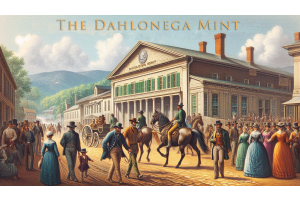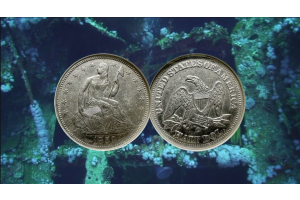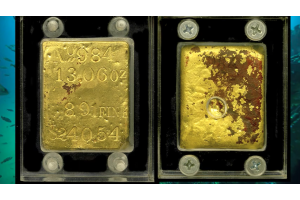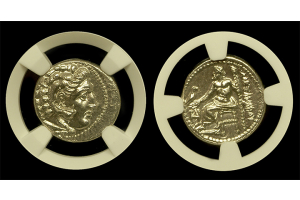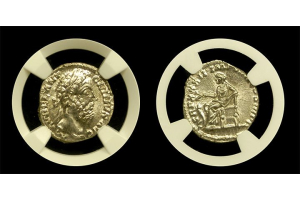1860 Pikes Peak Gold Rush
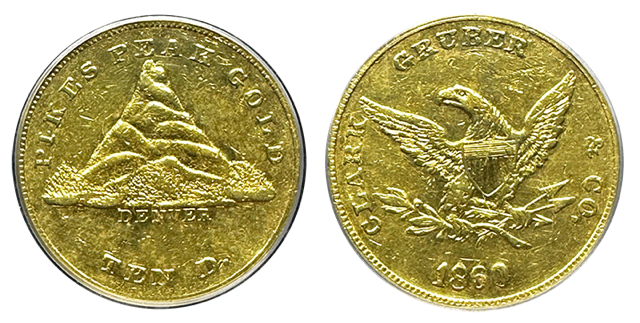
The 19th-century gold rush in the United States was an exhilarating era of opportunity. Especially, as it attracted individuals from diverse backgrounds to the goldfields in pursuit of their fortunes. During this period, Colorado played a pivotal role in the quest for gold, especially during the 1860 Pikes Peak Gold Rush. Amid this tumultuous time, one company particularly distinguished itself - Clark Gruber & Company. This article delves into the captivating history of Clark Gruber & Company during the 19th-century gold rush. Furthermore, it explores their distinctive coinage and the factors contributing to the relatively brief duration of their coinage enterprise.
Pikes Peak Gold Rush: A Golden Discovery
The story of Clark Gruber & Company is inextricably linked to the Pikes Peak Gold Rush. In 1858, Green Russell's discovery of gold flakes in the South Platte River ignited a frenzy. Meanwhile, drawing miners and prospectors to the area marked the commencement of the Colorado Gold Rush. However, an even more significant discovery lay on the horizon.
In 1859, a group of Georgia prospectors unearthed gold in the streams near the base of Pikes Peak. Subsequently, they were later dubbed the "Georgia Boys." Their discovery set off the Pikes Peak Gold Rush and a massive influx of prospectors into the region. Simultaneously, this led to the establishment of towns like Denver and Colorado City, transforming the area into a bustling hub of activity.
Clark Gruber & Company: A Unique Coinage Enterprise
During this gold rush, Samuel J. Clark and Augustus Humbert Gruber established Clark Gruber & Company. Significantly, it was a private mint and assay office situated in Denver, Colorado. As gold dust and nuggets poured in from miners, there was an urgent need for a trustworthy institution. In other words, they needed to assay the gold and convert it into a tradable form.
To address this demand, Clark Gruber & Company began crafting their coins. Particularly, the $10 gold pieces, and copper coins in $20 denominations. Each coin proudly bore the hallmark "Pikes Peak Gold" and featured meticulous designs. Therefore, reflecting the values and aspirations of the time.
The gold coins showcased a depiction of Pikes Peak with the word "Denver" beneath it. "Ten D." represented its denomination, while the copper coins displayed "Pikes Peak Copper." These coins paid homage to the renowned Pikes Peak region in Colorado, celebrated for its abundant gold reserves.
The reverse of the coins displayed a majestic American Eagle, firmly grasping an arrow with its right talons. Indeed, symbolizes power and readiness. On the left side, an olive branch signified peace, and "1860" was prominently inscribed at the bottom. Markedly, to denote the coin's minting year. At the top, "Clark Gruber & Co." was imprinted. This symbolizes the private mint's pivotal role in coinage during the Colorado Gold Rush.
The Uniqueness of Clark Gruber's Coins
Clark Gruber & Company's coins earned acclaim for several reasons. Their unique design was not only visually appealing but also highly practical. Moreover, the company was renowned for its precise assaying methods, ensuring that the gold content in their coins remained consistently reliable. This reputation for quality significantly enhanced the popularity of their coinage.
The Short-Lived Venture: What Led to Its Conclusion?
Despite their distinctive design and high-quality production, Clark Gruber & Company's coinage venture had a relatively brief existence. Whereas, most coins were minted in 1860. Several factors contributed to this outcome.
Initially, as the region's mining industry matured, the demand for a private mint dwindled. U.S. government mints began operating in Colorado, providing coinage services backed by the federal government. These government-issued coins gained preference due to their widely recognized value.
Secondly, the "Pikes Peak Gold" hallmark on Clark Gruber's coins posed challenges. As other mining regions in Colorado and the United States gained prominence, the association with Pikes Peak became limiting. Clark Gruber & Company's coinage was intrinsically linked to the Pikes Peak Gold Rush. Unquestionably, this narrow focus became a disadvantage as gold discoveries occurred in other regions.
Lastly, the financial Panic of 1860, stemming from the scarcity of gold and silver coins, prompted a shift in currency standards. With the Coinage Act of 1864, the U.S. government introduced legislation to address the coin shortage. As a result, the establishment of standardized coinage and the eventual discontinuation of private coinage.
The Gold Rush Wave and Its Impact
The initial stirrings of the 19th-century gold rush originated in the eastern United States. It started with the discovery of gold in North Carolina in the early 1800s. The news of these findings triggered a series of gold rushes across the nation. Therefore, necessitated the establishment of private mints to convert freshly mined gold into tradable coins.
However, by the mid-1800s, the nation's attention shifted westward. In 1848, the discovery of gold at Sutter's Mill in California set off the famous California Gold Rush. This massive wave of migration to the West Coast played a fundamental role in shaping the history of the United States.
As prospectors journeyed to California in pursuit of gold. Eventually, they came from every corner of the nation and even the world. The rapid growth of California's population and economy during the Gold Rush years played a pivotal role in its eventual statehood in 1850. Above all, firmly establishing it as a cornerstone of the American West.
The Colorado Connection
The California Gold Rush had a direct influence on the Pikes Peak Gold Rush and Clark Gruber & Company's activities. While California's goldfields captivated the nation's imagination, it didn't take long for news of rich gold deposits in Colorado to spread.
As word of gold discoveries near Pikes Peak reached prospectors' ears, a new rush was ignited. This marked the onset of the Pikes Peak Gold Rush, attracting thousands of miners and settlers to Colorado. And as mentioned before, including the "Georgia Boys" who made the historic discovery at Pikes Peak.
The Pikes Peak Gold Rush brought a surge of settlement and economic activity to Colorado, resulting in the establishment of towns and mining communities. Denver was initially a mining camp named after James W. Denver, the governor of the Kansas Territory. The area underwent rapid development, emerging as a center for miners and settlers heading to the goldfields.
Clark Gruber & Company played a crucial role in facilitating the circulation of gold coins during this pivotal time in Colorado's history. Their coinage venture stabilized and standardized currency as gold dust and nuggets flowed in from the mining operations in the region.
The Legacy of Clark Gruber & Company
Although the coinage venture of Clark Gruber & Company was relatively short-lived, their legacy lives on. Their distinctive coins, with their unique design and commitment to accuracy, remain highly sought after by collectors and numismatists. These coins hold historical significance, representing the dynamic and evolving nature of the American frontier during the 19th century.
Conclusion
In conclusion, the California Gold Rush and the subsequent 1860 Pikes Peak Gold Rush were intertwined chapters. Altogether, this adds to the larger narrative of American westward expansion. As one rush ignited the nation's imagination, the other lured pioneers to the promising landscapes of Colorado.
These historical events were marked by the quests for gold. Additionally, they underscored the transformative impact of the 19th-century gold rushes on the nation's development. Another key point that played into the story, was the unique role of private mints like Clark Gruber & Company in this rich history.






